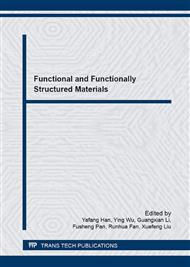[1]
Liu S, Zhou C, Yu W. Phase separation and structure control in ultra-high molecular weight polyethylene microporous membrane [J]. Journal of Membrane Science, 2011, 379(1-2): 268–278.
DOI: 10.1016/j.memsci.2011.05.073
Google Scholar
[2]
D.R. Lloyd, S.S. Kim, K.E. Kinzer, Microporous membrane formation via thermally-induced phase separation. II. Liquid–liquid phase separation, J. Membr. Sci. 64 (1991) 1–11.
DOI: 10.1016/0376-7388(91)80073-f
Google Scholar
[3]
M.R. Caplan, C.Y. Chiang, D.R. Lloyd, L.Y. Yen, Formation of microporous Teflon® PFA membranes via thermally induced phase separation, J. Membr. Sci. 130 (1997) 219–237.
DOI: 10.1016/s0376-7388(97)00027-6
Google Scholar
[4]
S.P. Nunes, T. Inoue, Evidence for spinodal decomposition and nucleation and growth mechanisms during membrane formation, J. Membr. Sci. 111 (1996)93–103.
DOI: 10.1016/0376-7388(95)00281-2
Google Scholar
[5]
C y. Chiang, D.R. Lloyd, Effects of process conditions on the formation of microporous membranes via solid–liquid thermally induced phase separation, J. Porous Mater. 2 (1995) 273–285.
DOI: 10.1007/bf00489808
Google Scholar
[6]
Castro A J. Methods for making microporous products: U.S. Patent 4, 247, 498[P]. 1981-1-27.
Google Scholar
[7]
van de Witte P, Dijkstra PJ, van den Berg JWA, Feijen J (1996) Phase separation processes in polymer solutions in relation to membrane formation. J Membr Sci 117(1–2): 1–31.
DOI: 10.1016/0376-7388(96)00088-9
Google Scholar
[8]
H. Matsuyama, H. Okafuji, T. Maki, M. Teramoto, N. Kubota, Preparation of polyethylene hollow fiber membrane via thermally induced phase separation, J. Membr. Sci. 223 (2003) 119–126.
DOI: 10.1016/s0376-7388(03)00314-4
Google Scholar
[9]
L. Shen, M. Peng, F. Qiao, J.L. Zhang, Preparation of microporous ultra high molecular weight polyethylene (UHMWPE) by thermally induced phase separation of a UHMWPE/liquid paraffin mixture, Chin. J. Polym. Sci. 26 (2008) 653–657.
DOI: 10.1142/s0256767908003394
Google Scholar
[10]
H. Sun, K.B. Rhee, T. Kitano, S.I. Mah, High-density polyethylene (HDPE) hollow fiber membrane via thermally induced phase separation. I. Phase separation behaviors of HDPE–liquid paraffin (LP) blends and its influence on the morphology of the membrane, J. Appl. Polym. Sci. 73 (1999).
DOI: 10.1002/(sici)1097-4628(19990912)73:11<2135::aid-app9>3.0.co;2-x
Google Scholar
[11]
Gu MH, Zhang J, Wang XL, Ma WZ (2006) Crystallization behavior of PVDF in PVDF-DMP system via thermally induced phase separation. J Appl Polym Sci 102(4): 3714–3719.
DOI: 10.1002/app.24531
Google Scholar
[12]
Lin YK, Tang YH, Ma HY, Yang J, Tian Y, Ma WZ, Wang XL (2009) Formation of a bicontinuous structure membrane of polyvinylidene fluoride in diphenyl carbonate diluent via thermally induced phase separation. J Appl Polym Sci 114(3): 1523–1528.
DOI: 10.1002/app.30622
Google Scholar
[13]
Yang J, Li DW, Lin YK, Wang XL, Tian F, Wang Z (2008) Formation of a bicontinuous structure membrane of polyvinylidene fluoride in diphenyl ketone diluent via thermally induced phase separation. J Appl Polym Sci 110(1): 341–347.
DOI: 10.1002/app.28606
Google Scholar
[14]
Chan C M, Wu J, Li J X, et al. Polypropylene/calcium carbonate nanocomposites[J]. Polymer, 2002, 43(10): 2981–2992.
DOI: 10.1016/s0032-3861(02)00120-9
Google Scholar
[15]
Zhao H, Li R K Y. A study on the photo-degradation of zinc oxide (ZnO) filled polypropylene nanocomposites[J]. Polymer, 2006, 47(9): 3207-3217.
DOI: 10.1016/j.polymer.2006.02.089
Google Scholar
[16]
Nguyen V G, Thai H, Mai D H, et al. Effect of titanium dioxide on the properties of polyethylene/TiO2 nanocomposites[J]. Composites Part B Engineering, 2013, 45(1): 1192–1198.
DOI: 10.1016/j.compositesb.2012.09.058
Google Scholar
[17]
Gu, M. -H.; Zhang, J.; Wang, X. -L.; Tao, H. -J.; Ge, L. Formation of poly (vinylidene fluoride) (PVDF) membranes via thermally induced phase separation Desalination 2006, 192, 160.
DOI: 10.1016/j.desal.2005.10.015
Google Scholar



